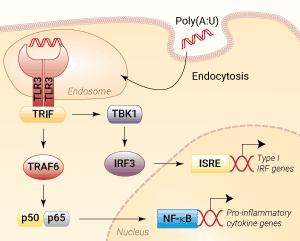Poly(A:U)
| Product | Unit size | Cat. code | Docs. | Qty. | Price | |
|---|---|---|---|---|---|---|
|
Poly(A:U) Polyadenylic-polyuridylic acid |
Show product |
10 mg |
tlrl-pau
|
|
TLR3 agonist - Polyadenylic-polyuridylic acid

TLR3 activation with Poly(A:U)
Polyadenylic–polyuridylic acid (poly(A:U)) is a synthetic double-stranded (ds) RNA molecule that signals through Toll-like receptor 3 (TLR3). This important pattern recognition receptor (PRR) recognizes dsRNA, a hallmark of viral replication, and triggers antiviral immune responses [1].
Mode of action:
Recognition of poly(A:U) by TLR3 induces TRIF-dependent signaling with the subsequent activation of the transcription factors NF-κB and interferon regulatory factor (IRF). This ultimately leads to the production of pro-inflammatory cytokines and type I interferons.
Notably, poly(A:U) has been shown to promote antigen-specific Th1-immune responses and boost antibody production [2]. Moreover, several studies have demonstrated that poly(A:U) can enhance anticancer immune responses [3-5].
Key features:
- Activator of TLR3
- Each lot is functionally tested
References:
1.Chen Y, et al., 2021.Toll-like receptor 3 (TLR3) regulation mechanisms and roles in antiviral innate immune responses. J Zhejiang Univ Sci B.22(8):609-632.
2. Wang L. et al., 2002. Noncoding RNA danger motifs bridge innate and adaptive immunity and are potent adjuvants for vaccination. J Clin Invest. 110:1175–84.
3. Le Naour J. et al., 2020. Trial watch: TLR3 agonists in cancer therapy. Oncoimmunology 9(1):1771143.
4. Roselli E. et al., 2019. TLR3 Activation of Intratumoral CD103+ Dendritic Cells Modifies the Tumor Infiltrate Conferring Anti-tumor Immunity. Front Immunol. 10:503.
5. Nocera D.A. et al., 2016. In vivo visualizing the IFN-β response required for tumor growth control in a therapeutic model of polyadenylic-polyuridylic acid administration. J Immunol . 196(6):2860-9.
Specifications
Specificity: TLR3 agonist
Working Concentration: 300 ng - 100 µg/ml
CAS number: 24936-38-7
Solubility: 1 mg/ml in physiological water (NaCl 0.9%)
Quality control:
- TLR3 activity has been tested using HEK-Blue™ TLR3 cells.
- The absence of bacterial contamination (lipoproteins and endotoxins) has been confirmed using HEK-Blue-Lucia™ hTLR2 and HEK-Blue-Lucia™ mTLR4 cells.
Contents
Poly(A:U) is provided lyophilized.
- 10 mg sterile lyophilized poly(A:U)
- 10 ml sterile physiological water
![]() Poly(A:U) is shipped at room temperature.
Poly(A:U) is shipped at room temperature.
![]() Upon receipt, store at 4°C.
Upon receipt, store at 4°C.
Back to the top
Details
Toll-Like Receptor 3
In humans, four Toll-Like Receptor (TLR) family members TLR3, TLR7, TLR8, and TLR9 are specialized in sensing viral-derived components and are mainly found in the endosome. Among these, TLR3 recognizes double-stranded (ds)RNA, a hallmark of viral replication, and triggers antiviral immune responses [1]. TLR3 is expressed in myeloid dendritic cells, macrophages, as well as non-immune cells [2].
TLR3 signaling
TLR3 activation upon viral infection involves several steps, including translocation of TLR3 from the ER (endoplasmic reticulum) via the Golgi to the endosome, proteolytic cleavage and dimerization of TLR3, and finally receptor-ligand binding [3]. In order to start the signaling cascade, activated TLR3 recruits the adaptor protein TRIF (TIR domain-containing adapter-inducing interferon-β). TRIF binds to TRAF3 (TNF receptor-associated factor 3), which then recruits TBK1 (TANK-binding kinase 1) and IKKε (IκB kinase ε), thus activating the transcription factor IRF3 (interferon regulatory factor 3) and stimulating the production of type I IFNs (interferons). Additionally, TRIF interacts with TRAF6 and RIP1 (kinase receptor-interacting protein 1). RIP1 in turn binds to TAK1 (transforming growth factor β-activated kinase 1) and IKK. TAK1 phosphorylates IKKα and IKKβ, leading to the phosphorylation of IκB, the NF-κB inhibitor. Ultimately, this leads to the release and translocation of NF-κB into the nucleus and the induction of pro-inflammatory cytokines [2,4].
References
1. Sironi M. et al., 2012. A Common Polymorphism in TLR3 Confers Natural Resistance to HIV-1 Infection. J Immunol 15; 188 (2): 818–823.
2. Aluri J. et al., 2021. Toll-Like Receptor Signaling in the Establishment and Function of the Immune System. Cells, 10, 1374.
3. Chen Y. et al., 2021. Toll-like receptor 3 (TLR3) regulation mechanisms and roles in antiviral innate immune responses. J Zhejiang Univ Sci B.;22(8):609-632.
4. Komal A. et al., 2021. TLR3 agonists: RGC100, ARNAX, and poly-IC: a comparative review. Immunol Res. 69(4):312-322.






